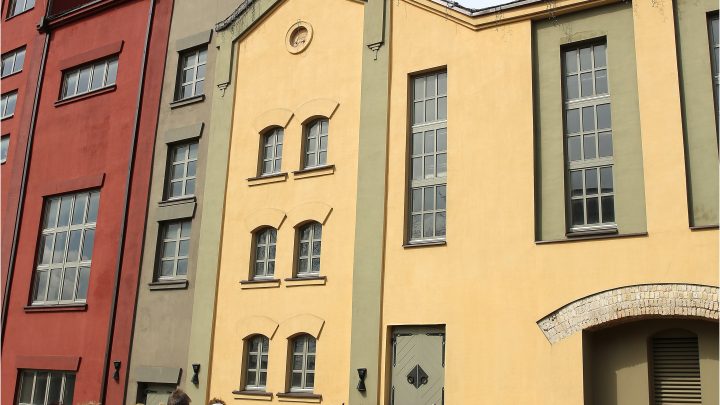Šiauliai streets tell their stories. Dvaro Street
The name of Dvaro Street was first mentioned in the city inventory of 1649. It connected the city centre with the manor that was located on the northern edge of the city. In the plan of 1852, the part of the street near Didždvaris was called Dvorianskaja ulica (Bajorų Street). This street connected Gubernija Manor with the residence of the Zubovai.
In the plans of 1871 and 1902, the street was marked as Malaya Sadovaya (Mažoji Parko Street), but this name did not take root. Until World War I, people called this street Dvornaja ulica (Dvaro Street).
During World War I, Germans named the street boundary from Vytauto Street up to the turn to Gubernija brewery Schloss Strasse (Rūmų Street), and after the war, a Lithuanian name Dvaro was given to it. In the plan of 1928, the sections branching from the territory of Gubernija brewery to the streets of Žemaitės and J. Basanavičiaus are called Gubernijos Street, and in the plan of 1934, the whole route of the street is already called Dvaro Street.
Gubernija Manor
The beginnings of Dvaro Street are Gubernija Manor.
The lands of Gubernija Manor covered the area from Joniškis Highway to Račiai village in the north and Voveriškės village in the west. The central mansion of the manor was built on the shores of the former Lake Vinkšna, next to the current Gubernija brewery. The centre of crown estate – Didždvaris Manor – was connected to Gubernija Manor House by the still existing Dvaro Street. After World War I, most of Gubernija Manor was expropriated by the Lithuanian government. The liquidation of Gubernija Manor was completed only in 1928. The central mansion and the manor workers’ house burned down during the war, the area of 470 ha around these buildings went to the city of Šiauliai, and the forest of Gubernija went to the Lithuanian government.
Didždvaris
Didždvaris Manor
It is believed that the current Didždvaris Manor was built after the reconstruction of a distillery built in the 18 century. The building acquired the current architectural expression after several reconstructions of the manor in the 19 century. Only few authentic interior elements of the building have survived to this day: the lobby columns, the white tiled stove, and the basement vaults.
Didždvaris Manor house was built as the central residence of Šiauliai Crown Estate. The mansion was also an important cultural and educational centre. At the end of the 19 century, a secret and later, a public library operated here. In the second half of the 19 century, the Citizens’ Club set up in the manor that was also a venue of festive evening parties on the weekends and gatherings of the city’s intelligentsia.
Stables
A two-storey stone masonry manor stable was built in the early 19 century but it soon lost its main function and was equipped for the needs of various institutions.
In 1875, the former stable was transformed into a children’s shelter under the auspices of Aleksandra Zubovienė.
In 1920, Šiauliai County Municipality established a public library in one of the rooms of the building, which was moved out from here a year later.
Between 1922 and 1936, the former stable of the Zubovai housed various divisions of the District Court. When the court moved to a new building on Aušros Avenue, the building went to the Riflemen’s Union and its library.
During the Soviet period, the District Court re-established and is still operating in the building.
The Kitchen
It is likely that this building belonging to the building complex of Didždvaris Manor was built together with the manor in the 19 century. The documents of the manor of that period refer to it as a kitchen. Along with the gradual transfer of manor buildings to the city’s public needs, the manor kitchen also lost its function. In the interwar period, it housed an exemplary primary school that belonged to the Teachers’ Seminary as well as the headquarters of Kaunas Duke Vaidotas 8 Infantry Regiment.
Jackus Sondeckis. A Burgomaster of Šiauliai City.
One of the most prominent personalities lived in Dvaro Street – the burgomaster of Šiauliai, public figure Jackus Sondeckis. The house of J. Sondeckis’ family stood between Dvaro and A. Mickevičiaus streets. After the first democratic elections to the city council in Šiauliai on February 20, 1925, the social democrat J. Sondeckis was elected the burgomaster of Šiauliai.
J. Sondeckis-Sonda held the position of the burgomaster of Šiauliai between 1925-1931. During the years of his leadership, Šiauliai healed the wounds of war, many new public buildings were built, social, health care and educational institutions were established, and social care issues were settled. When for political reasons J. Sondeckis as a social democrat was not allowed to participate in municipal elections, he worked as a director of the Šiauliai Health Insurance Fund, built Pageluvys camp for the children of the poor.
Nurokas’ Bank
The bank building of brothers Nurokai stood at the corner of Dvaro and Vilniaus streets. In 1933, they had 300 depositors. When the leather factory of brothers Nurokai was on the verge of bankruptcy, Nurokas’ Bank used depositors’ contributions to cover production losses and for brothers’ personal needs. Although brothers Nurokai knew that their factory was operating at a loss, seeking to attract depositors, they announced that they were making particularly much profit. After the fraud was discovered, brothers Nurokai were demanded to return 3,7 million
litas to depositors and the bank’s house was declared bankrupt. During World War II, the building burned down.








Leave feedback